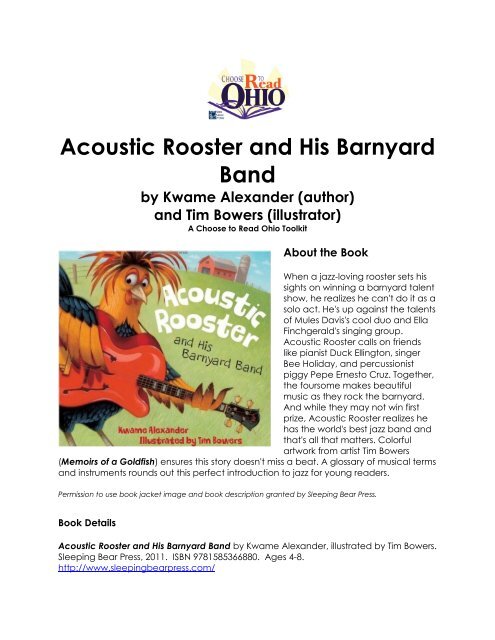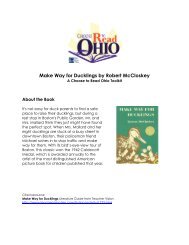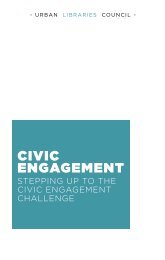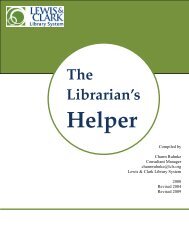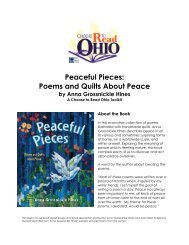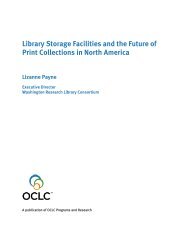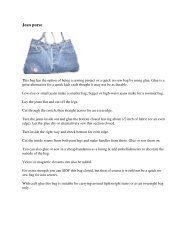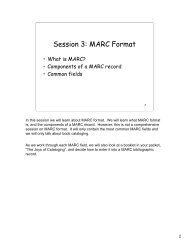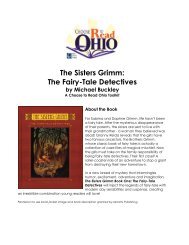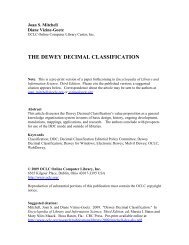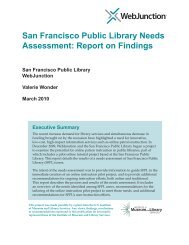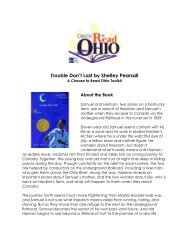Acoustic Rooster and His Barnyard Band - ALA Annual Conference
Acoustic Rooster and His Barnyard Band - ALA Annual Conference
Acoustic Rooster and His Barnyard Band - ALA Annual Conference
You also want an ePaper? Increase the reach of your titles
YUMPU automatically turns print PDFs into web optimized ePapers that Google loves.
<strong>Acoustic</strong> <strong>Rooster</strong> <strong>and</strong> <strong>His</strong> <strong>Barnyard</strong>B<strong>and</strong>by Kwame Alex<strong>and</strong>er (author)<strong>and</strong> Tim Bowers (illustrator)A Choose to Read Ohio ToolkitAbout the BookWhen a jazz-loving rooster sets hissights on winning a barnyard talentshow, he realizes he can't do it as asolo act. He's up against the talentsof Mules Davis's cool duo <strong>and</strong> EllaFinchgerald's singing group.<strong>Acoustic</strong> <strong>Rooster</strong> calls on friendslike pianist Duck Ellington, singerBee Holiday, <strong>and</strong> percussionistpiggy Pepe Ernesto Cruz. Together,the foursome makes beautifulmusic as they rock the barnyard.And while they may not win firstprize, <strong>Acoustic</strong> <strong>Rooster</strong> realizes hehas the world's best jazz b<strong>and</strong> <strong>and</strong>that's all that matters. Colorfulartwork from artist Tim Bowers(Memoirs of a Goldfish) ensures this story doesn't miss a beat. A glossary of musical terms<strong>and</strong> instruments rounds out this perfect introduction to jazz for young readers.Permission to use book jacket image <strong>and</strong> book description granted by Sleeping Bear Press.Book Details<strong>Acoustic</strong> <strong>Rooster</strong> <strong>and</strong> <strong>His</strong> <strong>Barnyard</strong> B<strong>and</strong> by Kwame Alex<strong>and</strong>er, illustrated by Tim Bowers.Sleeping Bear Press, 2011. ISBN 9781585366880. Ages 4-8.http://www.sleepingbearpress.com/
About the Illustratorhttp://library.ohio.gov/ctroTim Bowers has illustrated more than 25 children'sbooks, garnering such awards as the ChicagoPublic Library's "Best of the Best" list <strong>and</strong> severalJunior Library Guild selections. <strong>His</strong> work for SleepingBear includes First Dog <strong>and</strong> First Dog's White HouseChristmas.Even at a young age, Tim Bowers' artwork reflecteda strong sense of humor <strong>and</strong> an interest in animals.Prior to illustrating children's books, Tim worked as anartist for Hallmark Cards, where he helped launchthe popular Shoebox Greetings card line. <strong>His</strong> firstchildren's book, The Toy Circus, was published in1986. Tim's artwork has been included in the Societyof Illustrators <strong>Annual</strong> Art Exhibition <strong>and</strong> the S.I. HumorExhibition. <strong>His</strong> artwork has been featured inchildren's magazines <strong>and</strong> has appeared onhundreds of greeting cards. Original paintings fromseveral books are in private <strong>and</strong> institutional collections across the country. Tim lives withhis family in Granville, Ohio, <strong>and</strong> travels to schools <strong>and</strong> libraries to share his work withstudents.Biography <strong>and</strong> photograph courtesy Sleeping Bear Press; used with permission.Illustrator Resources:Tim Bower’s Official Websitehttp://www.timbowers.com/Illustrator page on Sleeping Bear Press website:http://sleepingbearpress.com/contributors/1312Tim Bowers’ biography from the Ohioana Book Festivalhttp://ohioanabookfestival.org/2011-authors/For publicity <strong>and</strong> speaking engagement inquiries:Please contact Audrey Mitnick at Sleeping Bear Press:audrey.mitnick@cengage.comAdditional contact information may be found at:http://www.timbowers.com/pages/contact.html
About the Authorhttp://library.ohio.gov/ctroKwame Alex<strong>and</strong>er is a poet, publisher, <strong>and</strong>award-winning producer of literary programs.He has written for television <strong>and</strong> the stage, <strong>and</strong>authored 13 books. <strong>Acoustic</strong> <strong>Rooster</strong> <strong>and</strong> <strong>His</strong><strong>Barnyard</strong> B<strong>and</strong> is his first children’s picture book.Kwame presents at conferences around thecountry. He conducts writing workshops atschools around the world through the nonprofit,Book-in-a-Day, Kwame lives in theWashington, D.C. area.Photograph <strong>and</strong> biographical information courtesy Sleeping Bear Press; used with permission.Author Resources:Kwame Alex<strong>and</strong>er’s official websitehttp://bookinaday.org/Author page on Sleeping Bear Press sitehttp://sleepingbearpress.com/contributors/1294Interview with Kwame Alex<strong>and</strong>er from NPR’s “Tell Me More”http://www.npr.org/2010/12/22/132259075/In-Your-Ear-Poet-Kwame-Alex<strong>and</strong>erFor publicity <strong>and</strong> speaking engagement inquiries:Please contact Audrey Mitnick at Sleeping Bear Press:audrey.mitnick@cengage.com
Get Ready To Read!Encouraging early literacy skill-building in young children.http://library.ohio.gov/ctro<strong>Acoustic</strong> <strong>Rooster</strong> is a good book for preschoolers as well as early elementary agedchildren. For pre-readers <strong>and</strong> early readers, many of the activities, ideas, <strong>and</strong> discussionquestions included in this toolkit incorporate the five practices that help young childrenget ready to read:Reading - Writing - Talking - Playing - SingingReading to <strong>and</strong> with a child is the single most important way to help children get ready toread as it helps develop six key early literacy skills: print motivation, phonologicalawareness, vocabulary, narrative skills, print awareness <strong>and</strong> letter knowledge. Writing(including drawing <strong>and</strong> scribbling) helps children learn about print, letters, <strong>and</strong>vocabulary, <strong>and</strong> helps establish pre-reading skills. Talking helps children learn orallanguage – a critical early literacy skill – <strong>and</strong> also increases vocabulary <strong>and</strong>comprehension. Playing helps children think symbolically, learn self-expression, <strong>and</strong> putthoughts into words. Singing slows language down so children can hear the differentsounds that make up words <strong>and</strong> develop letter knowledge <strong>and</strong> phonological awareness.All of these components lead to children being ready to learn how to read when theybegin school.Parents, teachers, <strong>and</strong> librarians are encouraged to utilize these activities with childrenwhether at home, in the classroom, or at the library.The Five Practices are featured in Every Child Ready to Read(http://everychildreadytoread.org), a library-based early literacy outreach initiative of thePublic Library Association <strong>and</strong> the Association for Library Service to Children. For moreinformation, please visit Ohio Ready to Read at http://www.ohreadytoread.org/.Talk About It!Topics to share when discussing <strong>Acoustic</strong> <strong>Rooster</strong> <strong>and</strong> <strong>His</strong> <strong>Barnyard</strong> B<strong>and</strong> with children.• Before reading <strong>Acoustic</strong> <strong>Rooster</strong>, talk to the children about what they already knowabout farms. What types of animals live on farms? What are crops <strong>and</strong> what cropsare grown on farms? Have the children ever seen a farm animal? If so, where?• <strong>Acoustic</strong> <strong>Rooster</strong> had fun competing in a talent show <strong>and</strong> doing what he loved,even though he did not win first prize. Why was <strong>Acoustic</strong> <strong>Rooster</strong> satisfied with thisoutcome? Have you ever competed for something but lost? How did it make youfeel? Did you give up or keep trying?• <strong>Acoustic</strong> <strong>Rooster</strong> enjoys playing his bass guitar <strong>and</strong> practicing all summer long.What do you love to do in your free time? Do you practice music, sports, dance,crafts, etc.?
http://library.ohio.gov/ctro• <strong>Acoustic</strong> <strong>Rooster</strong> <strong>and</strong> his b<strong>and</strong> performed so well together because they worked asa team. Talk to the children about the importance of working with others toaccomplish tasks, <strong>and</strong> allow them to share a time they had to work with someone tosucceed (housework, working with siblings, school work, etc.).Learn <strong>and</strong> have fun!Here are some fun ideas for extending the experience of reading <strong>Acoustic</strong> <strong>Rooster</strong>.• <strong>Acoustic</strong> <strong>Rooster</strong> includes a glossary of musical instruments (cow bell, baby gr<strong>and</strong>,bass guitar, percussion, etc.) Create instrument cut-outs <strong>and</strong> instrument labels.After the children have learned about the different instruments, test their knowledgeby having them match the labels to the pictures.• <strong>Acoustic</strong> <strong>Rooster</strong> makes analogies to famous jazz musicians. Have children researchElla Fitzgerald or any other musician mentioned in the book. Children can workindividually or in groups <strong>and</strong> provide a brief biography of that person. (This activitywould work best with 2 nd <strong>and</strong> 3 rd graders).• There are many musical terms in this book. Let children experience the musicfirsth<strong>and</strong>. Play selections by the jazz musicians referenced in the book. If yourschool has music education, invite the music teacher to talk to the students aboutdifferent instruments, <strong>and</strong> ask him or her to demonstrate the various sounds theymake. Afterward, have students discuss which instrument they liked best <strong>and</strong> why.• Throughout the book we see a cat, a bee, a monkey, <strong>and</strong> several barnyard animals.Assign a different animal to each child <strong>and</strong> have them do some basic research(what they eat, their habitat, physical characteristics, etc.).• Is there is a farm nearby that would be willing to give a class or group a tour? Havethe farmer discuss day-to-day activities, why farming is important, <strong>and</strong> what peoplecan do to support farming. (Field trip best suited for 2 nd <strong>and</strong> 3 rd graders.)• One of the factors bringing <strong>Acoustic</strong> <strong>Rooster</strong> to life is the vibrant <strong>and</strong> imaginativeillustrations. Have children draw a picture of their favorite animal <strong>and</strong> tell a storyabout it.• Fun storytimes to associate with <strong>Acoustic</strong> <strong>Rooster</strong> might include:o Farmso Animalso Crops <strong>and</strong> agricultureo Music/Jazzo Teamwork
Kid Songs: Farm Animalshttp://library.ohio.gov/ctro"On a Farm"(Sung to "London Bridge is Falling Down")Animals live on a farm, on a farm, on a farm.Animals live on a farm, with the farmer.Cows <strong>and</strong> pigs live on a farm, on a farm, on a farm.Cows <strong>and</strong> pigs live on a farm, with the farmer.Goats <strong>and</strong> sheep live on a farm, on a farm, on a farm.Goats <strong>and</strong> sheep live on a farm, with the farmer.Hens <strong>and</strong> chicks live on a farm, on a farm, on a farm.Hens <strong>and</strong> chicks live on a farm, with the farmer.“Five Little Ducks”Five little ducksWent out one dayOver the hill <strong>and</strong> far awayMother duck said"Quack, quack, quack, quack."But only four little ducks came back.Four little ducksWent out one dayOver the hill <strong>and</strong> far awayMother duck said"Quack, quack, quack, quack."But only three little ducks came back.Three little ducksWent out one dayOver the hill <strong>and</strong> far awayMother duck said"Quack, quack, quack, quack."But only two little ducks came back.http://www.dltk-kids.com/animals/farm-songs.htm
Tie It In!Using this book with Ohio’s Early Learning <strong>and</strong> Development St<strong>and</strong>ards.http://library.ohio.gov/ctroEducators: Here are examples of activities using <strong>Acoustic</strong> <strong>Rooster</strong> that align with Ohio’s EarlyLearning <strong>and</strong> Development St<strong>and</strong>ards at the Pre-Kindergarten level (3-5 years).Other st<strong>and</strong>ardsmay also apply.Librarians, parents, <strong>and</strong> others: The Ohio Department of Education adopted Ohio’s EarlyLearning <strong>and</strong> Development St<strong>and</strong>ards in 2012 to describe key concepts <strong>and</strong> skills that youngchildren develop during the birth-to-five year period. The purpose of these st<strong>and</strong>ards is tosupport the development <strong>and</strong> well-being of young children <strong>and</strong> to foster their learning. Thest<strong>and</strong>ards for ages 3-5 describe the developmental skills <strong>and</strong> concepts that young childrenshould know <strong>and</strong> be able to do by the end of their preschool experience. For more information,including the complete set of st<strong>and</strong>ards, follow this link to the Ohio Department of Educationsite: http://goo.gl/IE0xp.These activities may also be used in library programs, family activities, <strong>and</strong> other projects.Language <strong>and</strong> Literacy• Reading – Phonological Awareness. <strong>Acoustic</strong> <strong>Rooster</strong> is written using rhyming words<strong>and</strong> a rhythmic style. Giving modeling <strong>and</strong> support, help children recognize howthe words in the story rhyme, then practice producing rhyming words on their own.• Reading – Letter <strong>and</strong> Word Recognition. <strong>Acoustic</strong> <strong>Rooster</strong> features a fun cast ofbarnyard characters who bring <strong>Rooster</strong>’s musical dreams to life. Use each of thecharacters’ names (like Bee Holiday <strong>and</strong> Pork Chop) to help children recognize <strong>and</strong>identify the letters used to spell the name, <strong>and</strong> to begin to recognize the soundsassociated with the letters of the names <strong>and</strong> sound them out.• Writing – Writing Application <strong>and</strong> Composition. Begin pointing out the punctuationused in <strong>Acoustic</strong> <strong>Rooster</strong>, such as periods <strong>and</strong> commas. Encourage children tonotice punctuation in books <strong>and</strong> try using punctuation in writing exercises.Cognition <strong>and</strong> General Knowledge• Mathematics – Geometry: Identify <strong>and</strong> Describe Shapes. The musical instrumentsused by <strong>Rooster</strong> <strong>and</strong> his b<strong>and</strong> are full of different shapes. Point out the shapes yousee in the illustrations (like circles, triangles, <strong>and</strong> squares) as you read the book withchildren. Encourage them to recreate the shapes using pencils, crayons, paint, etc.• Science – Science Inquiry <strong>and</strong> Application: Inquiry. Let children join in the musicalfun of <strong>Acoustic</strong> <strong>Rooster</strong> <strong>and</strong> develop their inquiry skills by exploring musicalinstruments. Using real instruments or household items, have children explore howdifferent sounds are created with different instruments.
http://library.ohio.gov/ctro• Social Studies – <strong>His</strong>tory: Heritage. The jazz music featured in <strong>Acoustic</strong> <strong>Rooster</strong> wasborn out of European <strong>and</strong> African musical traditions. Help children begin todevelop awareness <strong>and</strong> appreciation of family cultural stories <strong>and</strong> traditions bysinging favorite songs together, creating special customs, <strong>and</strong> telling stories.Additional Activities <strong>and</strong> Ohio’s New Learning St<strong>and</strong>ardsEducators: Every Choose to Read Ohio book for children may be used to support Common CoreReading St<strong>and</strong>ards. Here are examples of activities using <strong>Acoustic</strong> <strong>Rooster</strong> that align withadditional content st<strong>and</strong>ards. These are examples. Other content st<strong>and</strong>ards may also apply.Librarians, parents, <strong>and</strong> others: These activities may also be used in library programs, familyactivities, <strong>and</strong> other projects. Academic Content St<strong>and</strong>ards define what students should know<strong>and</strong> be able to do at each grade. They are included for teachers who want to use this book inschool. For more information, see the Ohio Department of Education website,http://education.ohio.gov. Click on “Academic Content St<strong>and</strong>ards” in the Educators section.Science• Life Science – Physical <strong>and</strong> Behavioral Traits of Living Things. Develop students’underst<strong>and</strong>ing of what it means to be living <strong>and</strong> how living things grow <strong>and</strong> acquireenergy. Choose a few of the different animals featured in <strong>Acoustic</strong> <strong>Rooster</strong> (pig,duck, chicken, etc.) <strong>and</strong> talk about each animal’s eating habits, livingenvironments, <strong>and</strong> various characteristics. Share age-appropriate informationaltexts books to exp<strong>and</strong> their knowledge of these living creatures. (Kindergarten).Social Studies• <strong>His</strong>tory – <strong>His</strong>torical Thinking <strong>and</strong> Skills. Demonstrate to students how time can beshown graphically on calendars <strong>and</strong> timelines by examining the timeline found atthe end of <strong>Acoustic</strong> <strong>Rooster</strong> which chronicles the evolution of jazz music. Havestudents create a timeline of their lives, using pictures, words, maps, <strong>and</strong> knickknacksto demonstrate change <strong>and</strong> special events. (Grade 2).Math• Counting <strong>and</strong> Cardinality – Count to Tell the Number of Objects (K.CC.4). Developstudents’ underst<strong>and</strong>ing of the relationship between numbers <strong>and</strong> quantities bycounting different items on each page of <strong>Acoustic</strong> <strong>Rooster</strong>. Practice counting thenumber of animals you see, the number of instruments, etc. Help them underst<strong>and</strong> thatthe last number they count indicates the total number of objects counted <strong>and</strong> thateach object is paired with one <strong>and</strong> only one number. (Kindergarten).
http://library.ohio.gov/ctroEnglish Language Arts• Reading: Literature – Integration of Knowledge <strong>and</strong> Ideas (RL.1.7). After reading<strong>Acoustic</strong> <strong>Rooster</strong> together as a class, examine each page’s illustration/scene. Askstudents to describe what is happening in the story at that moment, based upontheir knowledge of the story <strong>and</strong> the ideas generated from the illustrations. Asthey respond, help them describe the relationship between illustrations <strong>and</strong> storyso that they can learn to use illustrations as cues for the written text as theydevelop early reading skills. (Grade 1).Explore More!Additional ideas <strong>and</strong> resources to use with <strong>Acoustic</strong> <strong>Rooster</strong>.Watch this!http://www.youtube.com/watch?v=gR5wGCxzVYUWatch Kwame Alex<strong>and</strong>er read <strong>Acoustic</strong> <strong>Rooster</strong> <strong>and</strong> <strong>His</strong> <strong>Barnyard</strong> B<strong>and</strong>.Farm Crafts: Fun for the Classhttp://www.enchantedlearning.com/crafts/farm/Choose from a variety of activities including a paper plate duck craft, cardboard boxbarn, <strong>and</strong> numerous printable activities.Ohio Farm Bureau: For Teachershttp://ofbf.org/education-<strong>and</strong>-reference/for-teachers/The OFB’s Agriculture in the Classroom program offers activities, workshops, tours, <strong>and</strong>curricular materials.Word Search Activityhttp://bogglesworldesl.com/files/easy_wordsearch_farmanimal.jpgAs an additional activity for children, complete a farm animal word search.About Choose to Read OhioChoose to Read Ohio, a project of the State Library of Ohio <strong>and</strong> the Ohioana LibraryAssociation, encourages public libraries, schools, families, <strong>and</strong> others to build a community ofreaders <strong>and</strong> an appreciation of Ohio authors <strong>and</strong> literature. CTRO is adaptable for use inclassrooms, libraries, bookstores, by book discussion groups, families, <strong>and</strong> other communitygroups.Explore Choose to Read Ohio resources & toolkits: http://library.ohio.gov/ctro.This toolkit created January 2012, rev. November 2012.


